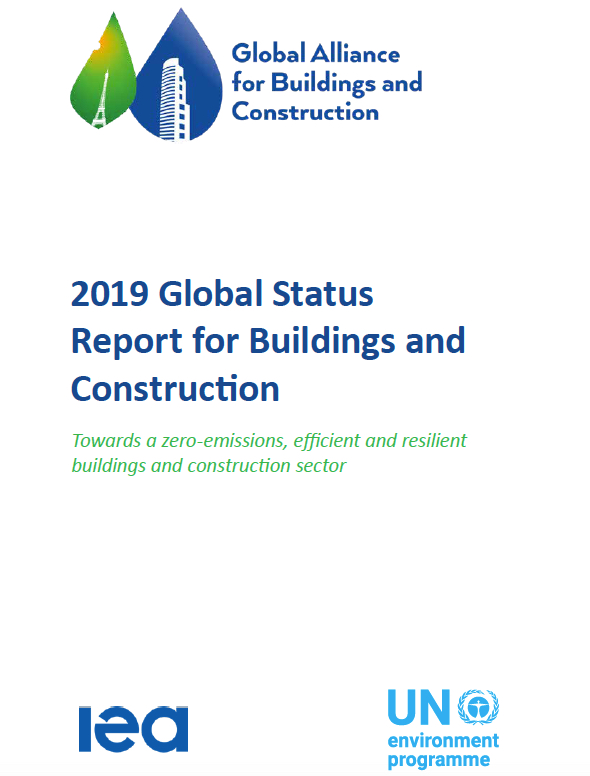Towards a Zero-Emissions, Efficient and Resilient Buildings and Construction Sector
Foreword
Decarbonizing the buildings and construction sector is critical to achieve the Paris Agreement commitment and the United Nations (UN) Sustainable Developments Goals (SDGs): responsible for almost 40% of energy- and process-related emissions, taking climate action in buildings and construction is among the most cost-effective. Yet, this 2019 Global Status Report on buildings and construction tells us that the sector is not on track with the level of climate action necessary. On the contrary, final energy demand in buildings in 2018 rose 1% from 2017, and 7% from 2010.
These findings stand in stark contrast with the 2019 Emissions Gap Report, which states that we will have to cut almost 8% of emissions each year from 2020, and are confirmed by the International Energy Agency (IEA) World Energy Outlook 2019, which found that in 2018 the rate of improvement in energy intensity had slowed to 1.2% – less than half the average rate since 2010. Both reports underline the need for urgent action by policy makers and investors. To meet the SDGs and the IEA Sustainable Development Scenario, we need to reverse the trend and make a concerted effort to de-carbonize and enhance energy efficiency in buildings at a rate of 3% a year.
In 2020, Nationally Determined Contributions (NDCs) under the Paris Agreement are due for revision – an opportunity that cannot be missed to ramp up ambition in the buildings and construction sector. The 2018 Global Status Report on buildings and construction found that a total of 136 countries have mentioned buildings in their NDCs, yet few have specified the actions they will use to reduce emissions. Therefore, in their new NDCs, nations must prioritize actions to decarbonise this essential sector. This means switching to renewable energy sources. It means improving building design. It means being more efficient in heating, cooling, ventilation, appliances and equipment. It means using nature-based solutions and approaches that look at buildings within their ecosystem, the city.
The report also tells us that the building stock is set to double by 2050, which presents another important opportunity not to be missed. In making good on SDG 11 with its provision for affordable and adequate housing for all, we need to make sure we promote clean solutions and innovations to make buildings future-proof. In line with SDG 7, we have to double our efforts on energy efficiency to bring gains of at least 3% per year.
Such efforts must be supported through investments in energy efficiency; but here also, the numbers show that we are headed in the wrong direction: investment in buildings sector energy efficiency flattened in 2018 instead of showing the growth needed. In September, at the UN Secretary General’s Climate Summit, countries as well as the private sector made commitments to a zero-carbon buildings sector, and the goal of mobilizing USD 1 trillion in “Paris-compliant” building investments in developing countries by 2030 was set. At the same time, the Net-Zero Asset Owner Alliance was founded with the world’s largest pension funds and insurers – responsible for directing more than USD 2.4 trillion in investments – committed to carbon-neutral investment portfolios by 2050.
These are signs of hope. And change is in the works. This report provides examples of country, city and private sector actions, of how the buildings and construction sector is reforming. Through this Global Status Report series, we are keeping an eye on progress made.
It is well within the realm of possibility for the buildings and construction sector to deliver its full mitigation potential and help the world achieve its climate and sustainable development goals. Together, we can build for the future.
Executive Summary
The buildings and construction sector accounted for 36% of final energy use and 39% of energy and process-related carbon dioxide (CO2) emissions in 2018, 11% of which resulted from manufacturing building materials and products such as steel, cement and glass. This year’s Global Status Report provides an update on drivers of CO2 emissions and energy demand globally since 2017, along with examples of policies, technologies and investments that support low-carbon building stocks. The key global buildings sector trends are:
- Global buildings sector emissions increased 2% from 2017 to 2018, to reach a record high, while final energy demand rose 1% from 2017 and 7% from 2010.
- Increases were driven by strong floor area and population expansions. While efficiency improvements continued to be made, they were not adequate to outpace demand growth.
- 2020 is a key year for countries to enhance their Nationally Determined Contributions (NDCs), especially concerning further actions to address energy use and emissions including embodied emissions in the buildings and construction sector.
- Countries are innovating and implementing measures to improve efficiency and reduce emissions from their building stock. As sharing effective measures globally would amplify their impact, regional roadmaps are being developed for this purpose.
Global Building Stock Emissions Continue to Rise
In 2018, global emissions from buildings increased 2% for the second consecutive year to 9.7 gigatonnes of carbon dioxide (GtCO2), suggesting a change in the trend from 2013 to 2016, when emissions had been leveling off. Growth was driven by strong floor space and population expansions that led to a 1% increase in energy consumption to around 125 exajoules (EJ), or 36% of global energy use.
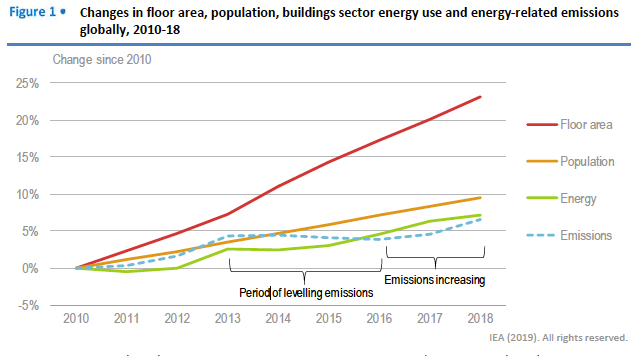
A major source of rising energy use and emissions by the global building stock is electricity, the use of which has increased more than 19% since 2010, generated mainly from coal and natural gas. This indicates how crucial it is to make clean and renewable sources of energy accessible, and to use passive and low-energy designs more widely in building construction. From 2017 to 2018, energy intensity continued to improve for space heating (-2%) and lighting (-1.4%), but increased for space cooling (+2.7%) and remained steady for water heating, cooking and appliances. At an 8% increase in 2018, space cooling became the fastest-growing use of energy in buildings since 2010, though it accounted for only a small portion of total demand at 6%.
2020 NDC revisions are a new opportunity to reduce buildings sector emissions
As part of their plans to limit greenhouse gas (GHG) emissions, 184 countries have contributed NDCs under the United Nations Framework Convention on Climate Change (UNFCCC). Although most countries (136) mention buildings in their NDCs, few detail explicit actions to address emissions within the buildings sector. In the next round of NDCs, covering 2020 to 2025, further focus is needed on actions to mitigate building emissions through switching to low-carbon and renewable energy sources, and greater attention should be paid to low-carbon building materials, building envelope improvements, nature-based solutions, and equipment and system efficiency. These efforts will require higher investments than the USD 139 billion of 2018 – which was a 2% drop from the previous year. To tackle emissions and reduce energy intensities in the buildings and construction sector, governments, companies and private citizens must raise investments in efficiency adequately to offset growth.
New Policies Lead the Way Forward
Although greater ambition is needed, policy makers, designers, builders and other participants in the buildings and construction value chain globally are undertaking activities to de-carbonize the global building stock and improve its energy performance.
- In a number of countries, building codes are being introduced for the first time or are being strengthened, for example in India through the Eco-Niwas Samhita India’s first energy conservation code for the residential sector, and in Rwanda through the Green Building Minimum Compliance System. Policies regulating the energy performance of new buildings are a powerful means to address future emissions growth.
- Building owners continue to adopt advanced certifications for high energy performance or low- and zero-carbon buildings, which stimulates improvements in both the new and existing building stock. The World Green Building Council offers support for such actions through its Net Zero Carbon Buildings Commitment that is being developed among its partners.
- Investors are establishing dedicated products and funding schemes for low-energy and low carbon buildings across the world. For example, the EU Green Tagging strategy that sets rules for European green financing is the first to include recommendations for net-zero energy buildings (nZEBs) and green renovation.
These activities to enact regulations and enable greater market adoption of low-energy buildings are encouraging signs of efforts to curb future energy demand and emissions. Some countries have also established strategies to work towards achieving a net-zero-carbon building stock by 2050 or earlier. For example, Japan and Canada are developing new policies to achieve net-zero and net-zero-ready standards for buildings by 2030. As more countries prepare their NDCs, more ambitious strategies to address existing building stocks will be put forward.
The Global Alliance for Buildings and Construction (GlobalABC) and the International Energy Agency (IEA), in collaboration with regional members and stakeholders, are developing Regional Roadmaps for Latin America, Africa and Asia to forge pathways towards efficient and resilient zero-emissions buildings and construction sectors. The roadmaps:
- Highlight priority actions for each region in eight key areas: urban planning; new buildings; existing building retrofits; building operations; systems; materials; resilience; and clean energy.
- Are being developed through consultations, workshops and webinars held across the three regions to gather insights and opinions from regional, national and local stakeholders on the targets and timelines for delivering an energy-efficient, low-carbon building stock.
- Are regionally owned living documents that will be shared by the end of 2019 and continue to be developed throughout 2020.
Support activities such as national alliances that unite local construction value chains to enable the development and implementation of national strategies for zero-net-energy and-emissions buildings.
Global Status
The buildings and construction sector globally is showing an increase in both emissions and energy use, limited progress on new and existing policies, and a further slowdown in energy-efficiency investment growth. More action is therefore needed to curb emissions and deliver a low-carbon, sustainable built environment.
Energy and emissions in the buildings and construction sector
Building construction and operations accounted for the largest share of both global final energy use (36%) and energy-related CO2 emissions (39%) in 2018 (Figure 2).
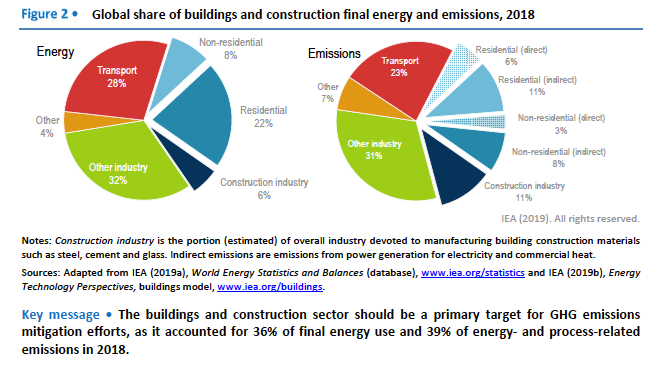
Energy Trends
Global final energy consumption in buildings in 2018 increased 1% from 2017, and by more than 8 EJ (about 7%) since 2010 (Figure 3). While strong growth in the main buildings sector resulted from floor space and population expansion outpacing energy efficiency gains, floor area growth continues to decouple from energy demand, with floor area in 2018 having increased 3% from 2017 and 23% since 2010.
From 2010 to 2018, global electricity use in buildings rose by over 6.5 EJ, or 19%. Emissions, which result from the fuel sources used for electricity generation and still include high levels of coal, especially in emerging economies, also rose in 2018. Continued de-carbonization of the electricity supply is therefore needed to transition to clean-energy, low-carbon buildings. Also during 2010-18, renewable energy became the fastest-growing energy source for buildings, with its use increasing 21% (up 3% during 2017-18 alone). Natural gas use rose 8% during the same period, meeting new demand as well as displacing coal use, which dropped by almost 10% globally during 2010-18 (-2% from 2017 to 2018).
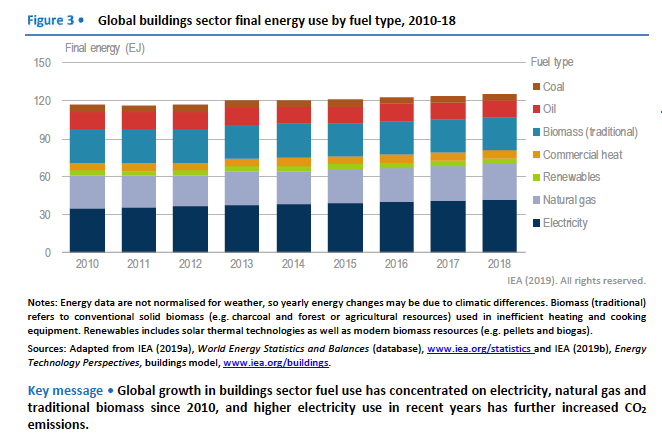
Globally, greater end-use energy consumption due to significantly higher electricity use since 2010 for space cooling, appliances and hot water, is resulting in increased emissions (Figures 4 and 5). Space cooling demand rose more than 33% during 2010-18 and by 5% in 2017-18, while energy demand for appliances in 2018 increased by 18% since 2010 and for water heating by 11%. At the same time, space heating demand decreased 1% from 2010, though it has remained
stable for the past five years at one-third of total global energy demand in buildings.
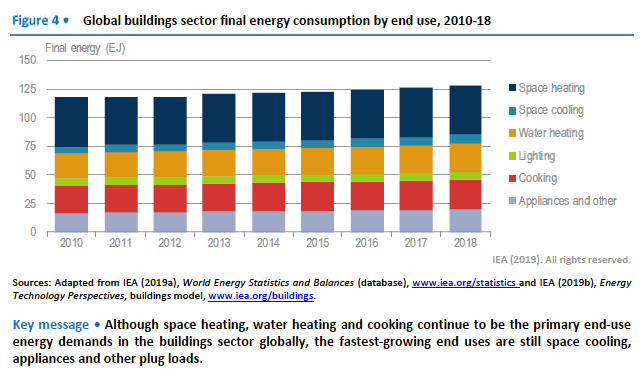
From 2010 to 2018, changes in buildings sector energy intensity per unit of floor area (as a proxy for energy efficiency) show that the greatest improvements (i.e. reductions) were in global average space heating (-20%) and lighting (-17%) (Figure 5). Light-emitting diodes (LEDs) continue to be important in reducing energy consumption for lighting as floor area increases and falling consumption for space heating indicates that building envelopes have improved. However, as floor area has been expanding rapidly in hot countries, cooling demand is increasing. As better building envelopes are crucial to reduce energy use for heating and cooling, building codes must remain a policy priority along with technology efficiency improvements.
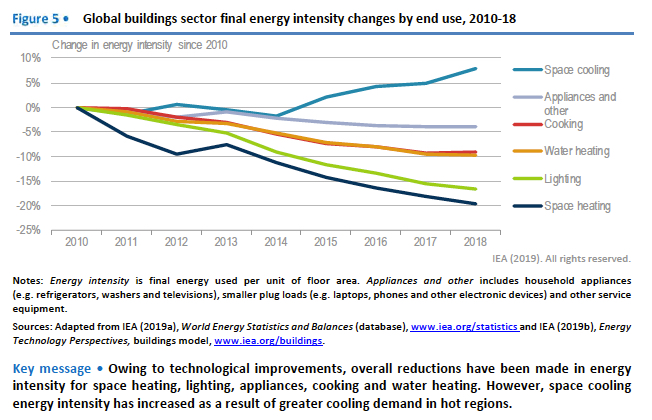
Factors influencing global buildings sector energy use include changes in population, floor area, energy service demand (e.g. more household appliances and cooling equipment), variations in climate and how buildings are constructed and used. Those that have contributed most to higher energy demand since 2010 are floor area, population and building use, while improvements in building envelopes (e.g. better insulation and windows) and in the performance of building energy systems (e.g. heating, cooling and ventilation) and components (e.g. cooking equipment) have helped to offset energy demand growth (Figure 6). Nevertheless, total energy demand in buildings continues to increase and greater investments in efficiency and passive design strategies are needed to limit demand and reduce energy intensity.
Final energy consumption in residential buildings made up more than 70% of the global total in 2018, with growth resulting primarily from floor area and population increases, while floor area alone remains the main driver of higher consumption in non-residential buildings (Figure 7). Consumption in residential buildings rose more than 5 EJ during 2010-18, and 3 EJ in non-residential buildings. Growth in residential demand continues to reflect population and floor area increases as well as development in emerging economies, along with a continued shift away from the traditional use of biomass towards modern fuels (e.g. electricity, liquefied petroleum gas and natural gas).
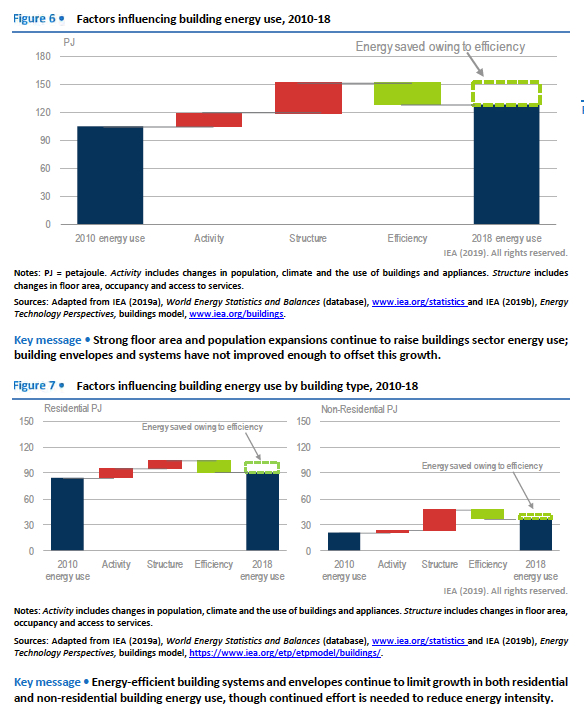
GHG Emissions Trends
In a reversal of the previous five years, buildings sector emissions appear to have risen to 9.7 GtCO2 in 2018 – an increase of 2% since 2017, and 7% higher than in 2010. Buildings represent 28% of global energy-related CO2 emissions (39% when construction industry emissions are included). Indirect emissions (i.e. from power generation for electricity and commercial heat) account for the largest share of energy-related CO2 emissions in the buildings sector, representing around 68% of total buildings-related emissions from energy consumption in 2018 (Figures 8 and 9). The increases in emissions in 2016 and 2017 correspond with floor area and population expansions as well as growth in electricity demand (i.e. indirect emissions). Building construction emissions – those related to the manufacturing of building materials – amounted to a further 11 GtCO2 in 2018, for a total of 39% of global energy-related emissions.
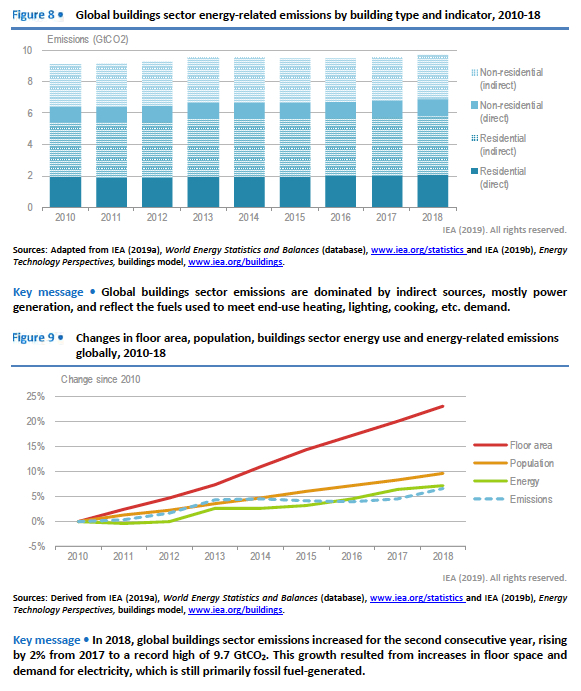
Sustainable Buildings and Construction Policies
By 2020, countries are requested to communicate their new or updated nationally determined contributions (NDCs) setting out their efforts to reduce national emissions and adapt to the impacts of climate change. 2020 is therefore a key year for countries to enhance their NDCs and commit to more aspirational targets. In addition to NDCs, the coverage and strength of energy performance building codes and certification policies have continued to expand, and in 2018 several countries with updated codes adopted meaningful improvements that should reduce buildings sector energy demand growth, especially for heating and cooling, and make buildings and construction more sustainable.
Nationally Determined Contributions (NDCs)
Reporting on NDCs is an international process during which countries announce their national-level commitments to reduce emissions to limit the rise in average global temperature to less than two degrees Celsius (°C) above pre-industrial levels by 2100, as set out in the Paris Agreement. The 24th Conference of the Parties (COP24) in Katowice, Poland, presented the Katowice Climate Package that sets out the procedures and mechanisms to operationalize the Paris Agreement. Within the package is guidance on communicating efforts to adapt to climate impacts; a transparency framework for efforts on climate change; a process for conducting a global stock take of overall progress towards the aims of the Paris Agreement; and directions for assessing progress on technology development and transfer. The package also contains directions for a further round of NDCs to be submitted by 2025.
To ensure comparability across all NDCs, it outlines how to develop mitigation goals and activities, specifically covering:
- mitigation co-benefits
- capacity-building support to help developing countries produce their NDCs
- a common time frame for communicating NDCs
- negative impacts of response measures on certain countries and sectors
- modalities for operating and using the public NDC registry.
To date, most countries (184) and the European Union have submitted NDCs, and many countries (136) mention buildings, although most NDCs still do not include explicit actions to address buildings sector energy use and emissions (Map 1). Seven countries updated their NDCs in 2018-19, and the Marshall Islands submitted their second NDC in 2019.
To help countries address buildings-related emissions, GlobalABC has developed guidance on how to include buildings in the NDCs through mapping, prioritizing, implementing, and monitoring (UNEP, 2018). GlobalABC supports ambitious buildings sector climate actions, defined as those that will move the sector towards zero emissions by 2050 while increasing the built environment’s resilience and adaptive capacity.
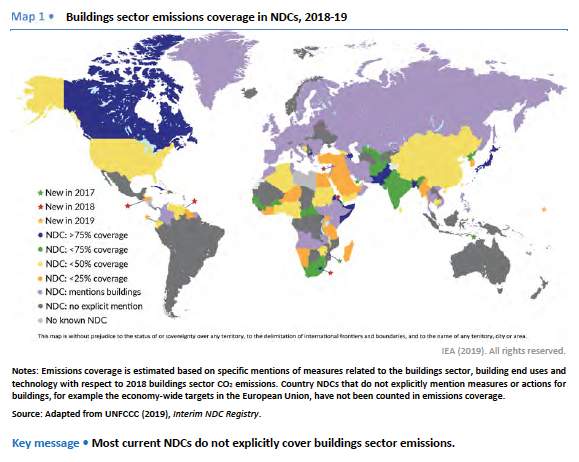
NDCs submitted in 2018-19 focus on improving building performance codes and standards, fuel conservation and phasing out inefficient products and equipment (Box 1).
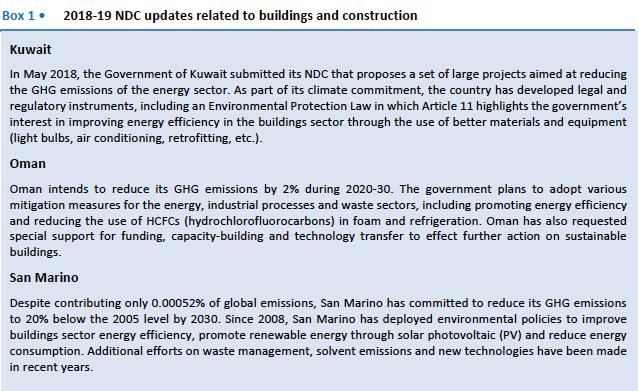
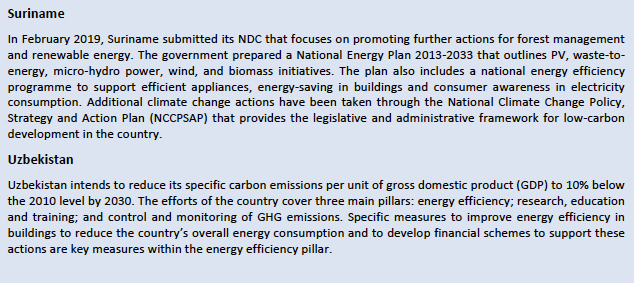
Of the 136 NDCs that now reference the buildings sector, most do not have specific targets or policy actions (Figure 10). While existing policies and NDCs covered more than 50% of buildings related CO2 emissions as of 2018,1 if committed NDCs were to become policy, the coverage would increase to more than 60%.
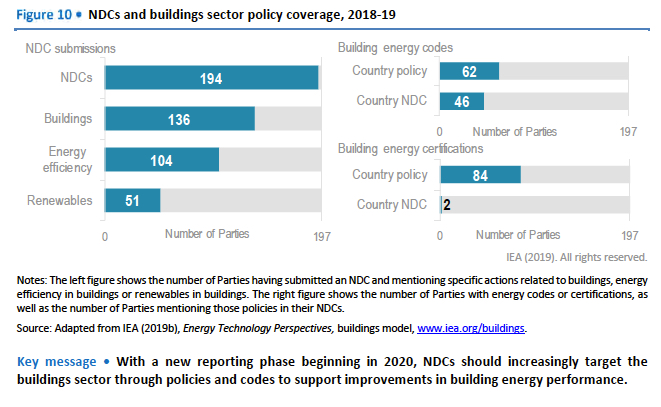
Building Energy Codes
Building energy codes, or standards, are requirements set by a jurisdiction (national or sub-national) that focus on reducing the amount of energy used for a specific end use or building component. In 2018, 73 countries had mandatory or voluntary building energy codes or were developing them.
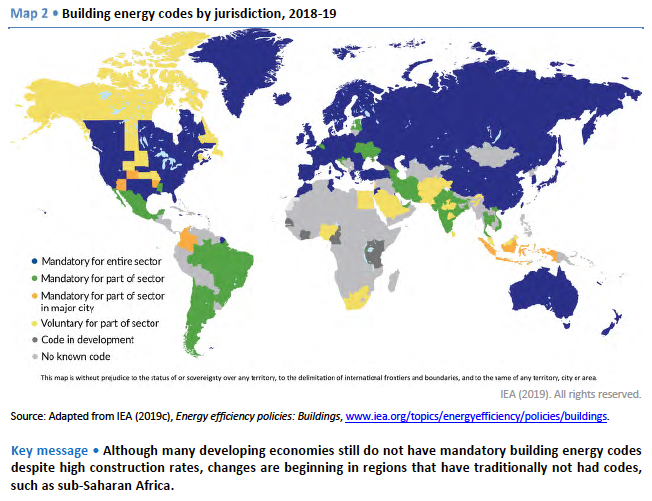
Building energy codes play an important role in setting standards for building construction that will reduce the long-term energy demands of the buildings sector. With mandatory and progressive codes, energy use can be better managed as floor space expands, and progressive codes can respond to changes in legislation and the availability of cost-effective technologies. For maximum impact, it is essential that a building code be strong, be improved progressively over time and be implemented effectively. It is also advisable to move towards mandatory codes for both residential and non-residential buildings.
Of the 73 countries with codes, 41 have mandatory residential building codes and 51 have mandatory non-residential codes; 4 have voluntary residential codes while 12 have voluntary non-residential codes; and 8 more are in the process of developing building codes. Greater coverage, adoption and strength are needed to continue improving the energy performance of new buildings and major refurbishments.
There is still considerable need for countries and sub-national jurisdictions to develop and effectively implement building energy codes to reduce future energy demand and avoid expensive retrofits later. There are signs, however, that such codes are being considered by a number of countries in central Africa and Central America.
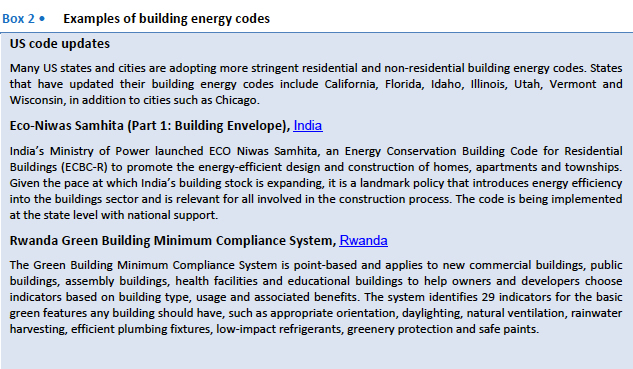
Building Energy Certification
Building energy certification involves programs and policies that evaluate the performance of a building and its energy service systems. Certification may focus on rating a building’s operational or expected (notional) energy use, and can be voluntary or mandatory for all or part of a particular buildings sector. The aim of energy performance certification for buildings is to provide information to consumers about their buildings and to gradually create a market for more efficient buildings.
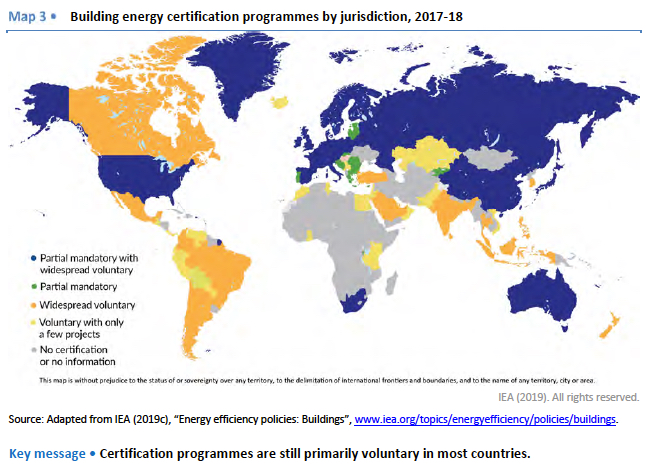
As of 2018, 85 countries had adopted building energy performance certification programs(Map 3), and several countries and sub-national jurisdictions also updated their building energy certification policies in 2017-18 (see Box 3). The use of certification programs is growing, with voluntary certification for high-end buildings becoming a popular means of adding value, but there is still a lack of large-scale adoption of full, mandatory certification programs outside the European
Union and Australia. This means that tracking building energy performance over time and subsequently disclosing the information is still limited.
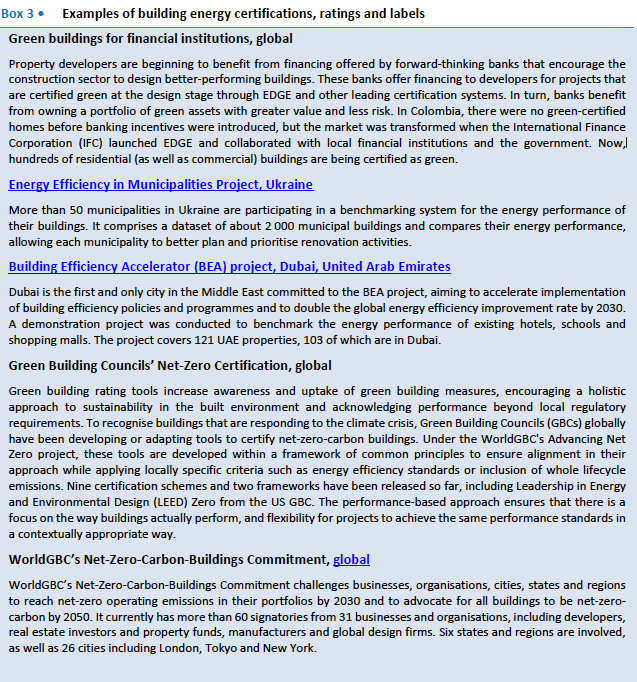
Investment and Financing for Sustainable Buildings
Total energy efficiency spending2 on buildings amounted to USD 139 billion in 2018 (Figure 11), a decline of 2% from 2017 (IEA, 2019). Driving this deceleration is the slowdown in investment within the European Union, even though the United States and China continue to invest in more energy efficient building systems. Within Europe, governments have either limited investment expansions (e.g. the United Kingdom and France) or have cut it back (e.g. Germany). In China, by comparison, overall real estate investment has grown 6% per year since 2015 to over USD 1.8 trillion in 2018. Chinese investment has been focused largely on residential buildings, with investments in efficiency rising to USD 27 billion in 2018 – a 33% increase from 2015. In the United States, investments in both residential and non-residential construction grew at a rate of 3.8% from 2015 to 2018, to reach USD 1.4 trillion, but the share of investment for improving building energy efficiency is in decline at 2% of total 2018 investment. The real estate market continues to embrace and invest in green buildings and green-building rating systems, with their overall Environmental, Social and Governance (ESG) scores increasing, which is a promising sign for the sector (GRESB, 2019). The 2018 Global Status Report (IEA and UNEP, 2018) provides further details on past investment and financing in sustainable buildings.
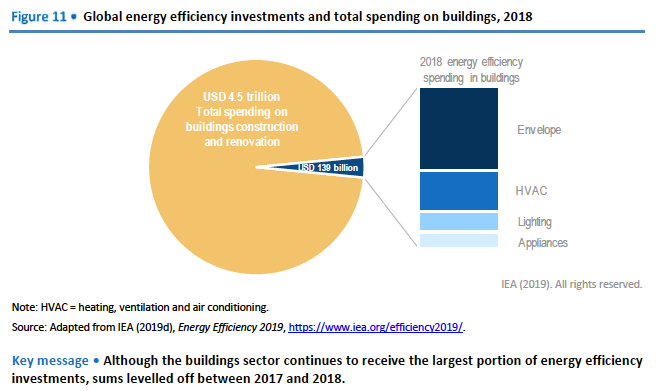
The overall investment trend mirrors slower progress for energy efficiency outcomes, with 2018 marking the third consecutive year in which the energy efficiency improvement rate slowed. An underlying factor was the static energy efficiency policy environment in 2018, with little progress made in implementing new efficiency policies or increasing the stringency of existing ones.
Global Survey
In the summer of 2019, an online questionnaire was sent to all GlobalABC members requesting their input for the 2019 Global Status Report, as well as case studies. The questionnaire provided members the opportunity to highlight their activities in support of low energy and low-carbon buildings and cities through actions such as new or improved building codes and standards, building certifications and NDCs. The following sections present insights from the responses.
Survey Findings
The survey received 43 responses from a mixture of civil society organisations (30%), national governments (28%), the private sector (21%), non-governmental organizations (NGOs) (7%) and others. Although the majority of countries noted that no updates had been made to their NDCs in 2017 or 2018, several had updated their commitments relating to strategies for 2050 on buildings and construction (see Box 4) and most that responded had begun the 2020 revisions process.
A number of countries identified financing schemes to facilitate investment in low-emissions buildings through forms of green financing, for example a state grant in Sweden to support low rent apartments, whereby a higher grant can be received if the building’s energy performance surpasses the building code. In Senegal, local governments are offering reduced taxes on development when local materials are used in housing construction.
In 2018 and 2019, building energy codes were updated in three respondent countries: Colombia, Japan and Senegal. For Colombia, this involved revision of its mandatory local and regional building energy codes for both residential and non-residential buildings, covering public and transport spaces for the first time. Japan’s revisions included an update to the national partially mandatory energy code for both residential and non-residential buildings.
Several countries are considering innovative building codes or expanding existing ones to cover broader lifecycle emissions beyond energy. For example, Sweden is investigating addressing the environmental impact of new buildings by using an environmental certification. Currently in the process of revising its CO2 Act, Switzerland is considering introducing a very strict CO2 emissions cap for existing buildings, which in most cases would result in the banning of fossil fuel-based heating systems unless the building is very well insulated. Meanwhile, Canada’s codes seek to leverage high-performance technologies and construction practices that are at the commercialization stage, and to include more climate change adaptation and resilience measures.
Building energy performance certification remains largely voluntary among respondent countries, with some exceptions for certain building types (commercial buildings in Tokyo, New York and Singapore, for example) or locations (e.g. both residential and non-residential buildings in the European Union). A range of certification types are being used around the world to indicate performance, and they are a mix of predicted and measured approaches. Respondents that recently updated their certifications include Sweden (2018), which has included mandatory overage for all building types, and Medellin, Colombia (2019), which updated its voluntary coverage for residential and commercial buildings.
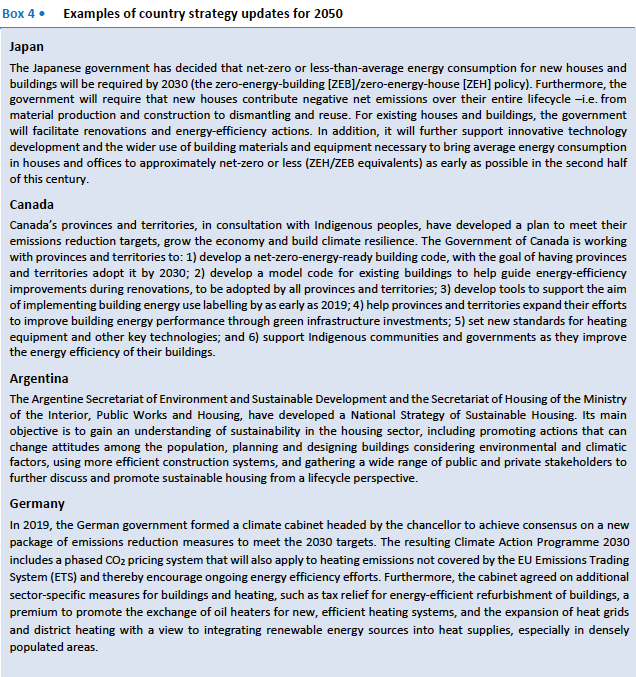
Global Roadmap Recommendations
A global transformation to a highly energy-efficient and low-carbon buildings and construction sector is essential to realize global ambitions to limit the rise in average global temperature to less than 2°C above pre-industrial levels by 2030. The critical window of opportunity to address buildings and construction emissions is in the coming decade, to avoid locking in inefficient buildings for decades to come. There is an equally critical need to address energy performance improvements and emissions reductions in the world’s existing building stock.
The following section outlines the key priority areas identified in GlobalABC’s 2016 Global Roadmap (UNEP and GlobalABC, 2016) as well as the actions necessary to deliver a zero-carbon global building stock.
Future GlobalABC work includes developing regional roadmaps to provide targets that are more country- and region-specific. For further information on best practices and examples of existing policies and technologies for the buildings sector, see www.iea.org/buildings. Updates on Global Roadmap activities
GlobalABC roadmaps focus on developing a collaborative approach across eight thematic areas necessary to create a sustainable built environment for the future. Efforts exemplifying roadmap ideas are being made in countries and cities all around the world, and this section highlights numerous country-level case studies across various themes as examples of these activities (Box 5).
Urban Planning
Urban planning policies should be used to reduce energy demand, increase renewable energy capacity and improve infrastructure resilience. Globally, local jurisdictions have significant control over how energy is used, and the emissions created by transportation, building construction and lifetime building operations can be regulated through urban planning. Urban planning can also help combat climate risks by ensuring building resilience. Key actions in the area of urban planning include:
- Enacting urban planning policies that account for the long-term goal of de-carbonizing the buildings and construction sector.
- District energy planning, i.e. enabling a systemic approach that can integrate energy demand and supply at the district level to deliver more efficient low-carbon solutions.
New Buildings
There needs to be a higher uptake of net-zero-operating-emissions buildings. With the global population increasing by 2.5 billion by 2050, new buildings will have an important effect on future buildings-related energy use and emissions. Several key policy, investment and design actions can achieve sustainable (low-emissions, efficient and resilient) new buildings:
- Develop and implement mandatory codes. Transition from voluntary to mandatory codes that set a minimum efficiency for new buildings.
- Strengthen building codes. Establish a building code improvement cycle to strengthen performance requirements every three to five years, with the aim of achieving zero emissions and net-zero-energy codes.
- Integrate renewable energy into new building designs to achieve net-zero emissions or net-zero energy.
- Mobilize sustainable building financing. Facilitate widespread designing and construction of sustainable buildings by raising access to/use of financing to enable private investment.
- Lead by example. Develop policies ensuring that all new government facilities are efficient low-emissions buildings.
Existing Buildings
The rate of energy renovations and the level of energy efficiency in existing buildings need to be increased. Key steps to raise the performance of existing buildings involve increasing both the number of buildings improved and the amount of improvement achieved.
- Increase renovation rates in industrialized countries to an average of 2% of existing stock per year by 2025, and to 3% by 2040. Renovation rates in developing countries should reach 1.5% by 2025 and 2% by 2040.
- Increase the depth of renovation. Enable deep energy renovations that reduce energy consumption of existing building by 30-50% or more.
- Make renovation financing available. Raise renovation rates by increasing access to/use of financing to enable private investment in renovations.
- Lead by example. Develop policies ensuring that existing government facilities are renovatedto become efficient low-emissions buildings.
Building Operations
Better energy management tools and operational capacity-building can reduce the amount of operating energy needed and, hence, emissions. While delivering efficient and resilient low emissions new or renovated buildings is essential, it is equally important to manage existing buildings efficiently. Key actions to improve the energy management of buildings include:
- Installing energy management systems. Offer training in energy management systems and use energy management processes in all buildings, particularly non-residential ones.
- Strengthening human resources. Hire sustainability and energy managers and support capacity-building among them.
- Using smart controls. Deploy temperature, lighting and ventilation system controls and sensors as well as energy metering.
- Making information accessible. Provide data and information that will help building operators and occupants make better decisions.
Systems
It is important to reduce energy demand from systems, appliances, lighting and cooking. Energy consuming lighting, appliances and equipment systems, which commonly have a shorter lifetime than the buildings they are in, offer a significant opportunity to reduce emissions in new and existing buildings. Key actions to increase system sustainability in buildings include:
- Establishing minimum energy performance standards (MEPS). Develop, enforce and improve standards to set product quality and performance requirements.
- Mobilizing financing for clean systems. Facilitate the use of sustainable products by increasing access to/use of financing to enable private investment.
- Leading by example. Develop policies ensuring that all government buildings invest in low emissions and efficient systems.
Materials
Taking a lifecycle approach can reduce the environmental impact of materials and equipment in the buildings and construction value chain. Key actions to increase the sustainability of building materials and products include:
- Encouraging people to purchase low-energy and low-emissions products and materials by implementing policies that promote better purchasing decisions based on embodied carbon and energy.
- Reducing demolition by implementing policies to help people make better decisions based on the impact of building demolition versus reuse.
- Recycling construction materials. Support the development of material recycling processes for products and materials that can reduce lifecycle embodied energy and emissions.
- Phasing out high-global-warming-potential (GWP) refrigerants through policies and technology evolution, enabling a phase-down and then phase-out of refrigerants that give off global warming emissions.
- Introducing information and awareness campaigns to disseminate information on low-carbon materials and technologies (e.g. wood and earth constructions, innovative concrete) among professionals involved in building design and construction.
- Leading by example, by developing policies that ensure all government buildings invest in low emissions and efficient materials based on lifecycle analyses.
- Developing a circular economy by embracing a cradle-to-grave or cradle-to-cradle lifecycle approach in the buildings sector to promote systemic, material-neutral, performance-based methods and business models.
Resilience
Building risks related to climate change can be reduced by adapting building designs and improving resilience. Key actions to increase the resilience of buildings include:
- Incorporating risk-zoning into urban planning. Use data and information to document potential risk exposure by location to enable improved decision-making during the building and infrastructure design process.
- Employing wind- and seismic-resistant construction methods. Implement policies and use best-practice designs and strong materials to make buildings more resistant to natural disasters and extreme weather events.
- Managing storm water. Require improved storm water retention within properties to reduce the negative impacts of water flowing to other properties and to surging waterways.
- Endorsing thermal-resistant construction. Implement policies and use best-practice designs to make buildings more resistant to extreme temperatures. The anticipated increase in cooling demand in particular needs to be addressed through the promotion of building designs that avoid excess cooling demand and use passive cooling measures and external shading.
Clean Energy
Increasing access to secure, affordable and sustainable energy can reduce the carbon footprint of energy demand in buildings. Key actions to support the clean energy transition in buildings include:
- Integrating onsite renewable energy by including building-integrated photovoltaic (BIPV), solar thermal and micro-wind renewable energy projects in the planning and design of buildings and neighborhoods.
- Eliminating onsite fossil fuel-burning equipment by replacing systems with equipment that use clean energy, including highly efficient heat pump technology.
- Connecting buildings to low-emissions district energy systems. Support district energy system clean-energy transitions by connecting buildings when districts commit to upgrade their systems to clean energy.
- Purchasing only green power to support electricity grid clean-energy transitions.
- Implementing zero-carbon policies that support the clean energy transition based on the lifecycle benefits of the measures.
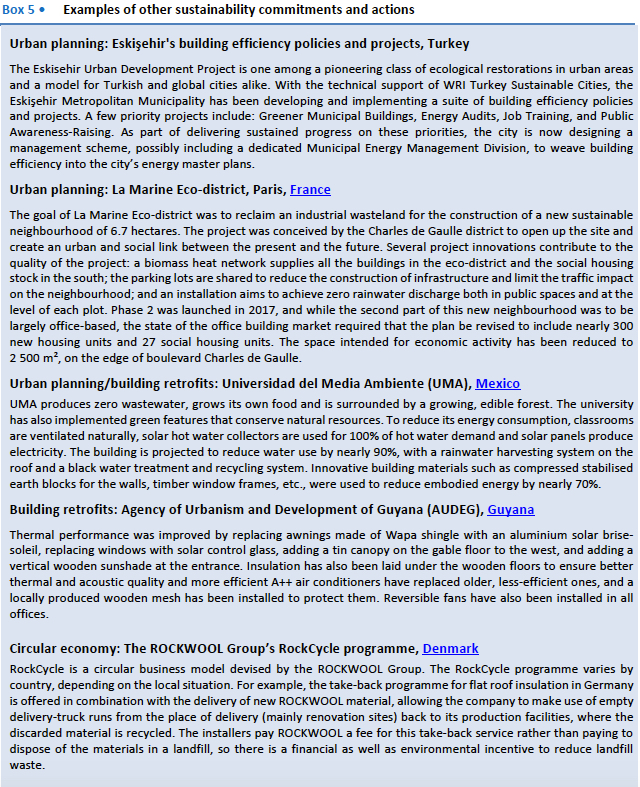
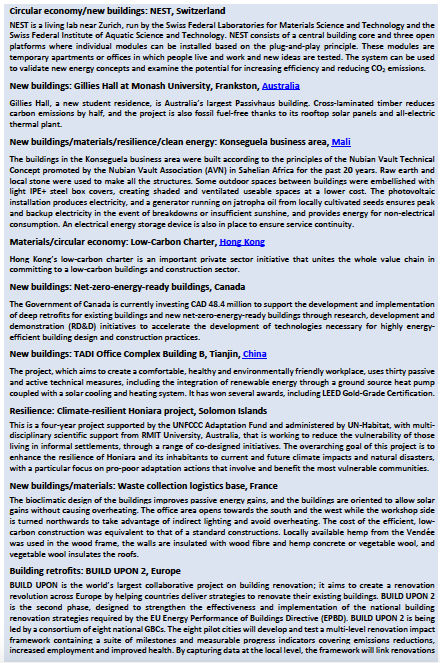
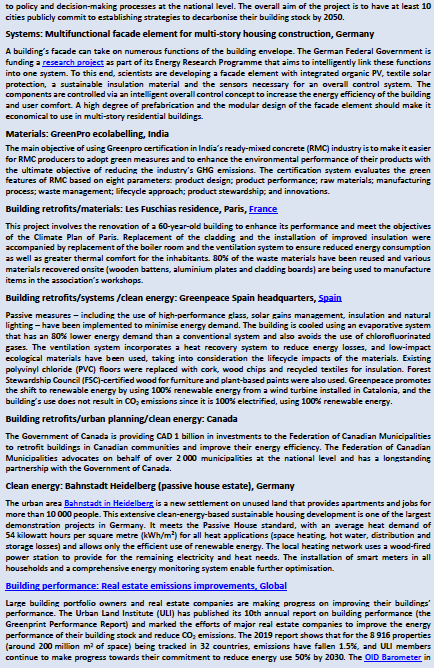
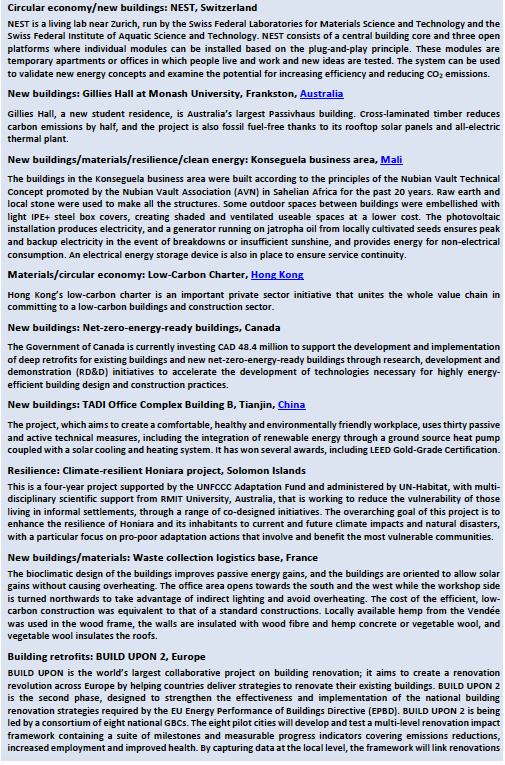
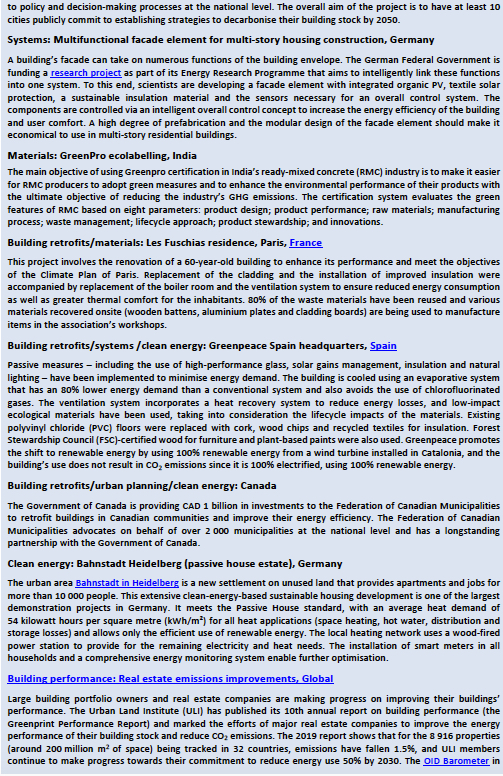
GlobalABC Work Areas
GlobalABC aims to bring together all elements of the buildings and construction industry as well as countries and stakeholders to raise awareness and facilitate the global transition to low-emissions, energy-efficient buildings. GlobalABC works on a voluntary collaboration basis in five working areas in which members are invited to take part.
Work Area 1: Awareness and Education
The purpose of this area is to support capacity-building to promote the transition to a resilient, efficient and zero-emissions built environment and to raise awareness of the sector’s transformation potential, convey a sense of urgency, develop common narratives, and formulate key messages. It aims to disseminate new approaches and solutions, share best practices through the new GlobalABC website, establish an interactive knowledge database to enhance peer learning, and provide training and education through webinars and online courses.
Work Area 2: Public Policies
This area attempts to unite the numerous independent and scattered building and construction sector stakeholders – particularly public authorities – through effective regulations and norms as well as financial and fiscal incentives. It also aims to support the development of national alliances, promote the integration of sustainable building objectives into NDCs, and enable city and sub-national engagement. A local government public policies group has been created to identify opportunities, facilitate community-level climate and energy strategies and promote co‑ operation among national and sub-national governments. Another sub-group focuses on adaptation and is developing a report to be released in 2020 on how the building industry is readjusting.
Work Area 3: Market Transformation
This area is designed to engage businesses and other stakeholders in de-carbonizing the entire buildings sector value chain, fostering multiple partnerships and a common culture among private and public sector participants to facilitate market transformation. This involves defining voluntary arrangements to prepare regulations and enable innovation in the market. It also include developing guidance on science-based targets that can be used to help transform the buildings and construction sector by identifying a common metric and language for all companies to use through the Science-Based Targets for Buildings (SBT4buildings) project led by the World Business Council or Sustainable Development (WBCSD).
Work Area 4: Financing
This area is working to narrow the public and private financing gap for investing in efficient and resilient zero-emission buildings and construction, including property development. It is also helping draw attention to the sector’s financing needs, mapping existing financing opportunities,promoting innovative financing tools, enabling the flow of reliable information for investors, and informing public bodies of the budgeting and funding policies needed to conceive and implement energy efficiency measures in buildings. For example, the International Partnership for Energy Efficiency Cooperation (IPEEC) and the Japanese government organized the G20 Global Summit on Financing Energy Efficiency, Innovation and Clean Technology, recognizing in its final Tokyo Declaration how important it is for the real estate and buildings sector to begin shifting financing towards energy efficiency.
Work area 5: Measurement, Data and Information
The purpose of this work area is to elaborate a fair and harmonized measurement system to close the information gap and thereby support buildings and construction sector policies and investments with measurable, reportable and verifiable data. Key barriers, however, relate to information availability, collection, quality, reporting, storage and accessibility. To overcome these obstacles, the work area team is coordinating an industry-wide global effort to develop a digital building data and information collection tool, known as a “building passport”, to promote greater cross-sectoral data transparency and consistency and information exchange. All work areas welcome new participants. Please contact global.abc@un.org for more information.
Global ABC Members and Activities
Launched at COP21, GlobalABC is a voluntary partnership of national and local governments, intergovernmental organizations, businesses, associations, networks and think thanks committed to a common vision: an efficient and resilient zero-emissions buildings and construction sector. GlobalABC functions as an umbrella or meta-platform – a network of networks – that brings together initiatives and participants focused on the buildings and construction sector. The GlobalABC network currently has 128 members, among which are 29 countries (Map 4), and it welcomes new members interested in contributing to the global transition to a low-carbon, energy-efficient and resilient buildings and construction sector.

Program for Energy Efficiency in Buildings
The French and German governments jointly initiated the Program for Energy Efficiency in Buildings (PEEB) at the end of 2016 at COP22, and the program was catalyzed by GlobalABC. PEEB supports implementation of the Global Roadmap: Towards Low-GHG and Resilient Buildings in its first partner countries: Mexico, Morocco, Senegal, Tunisia and Viet Nam. PEEB is a partnership program implemented by the Agence Française de Dévelopment, Deutsche Gesellschaft für
Internationale Zusammenarbeit GmbH and the Agence de l’Environnement et de la Maîtrise de l’Énergie (ADEME). PEEB has identified EUR 600 million worth of energy-efficient building projects and has already committed EUR 160 million.
National Alliances: Mobilizng for a Buildings Sector Transition
Action at the national level is needed to work towards an efficient and resilient zero-emissions buildings sector, and national alliances are ideal to help various professions connect and exchange information, and to make the topic more visible in national policy debates. Alliances can be organized by the public or private sector as either volunteer-based or formalized structures. National alliances offer recommendations for policy makers and actively work to enhance economic activity. Typical pursuits range from awareness-raising, training sessions and project assistance to legislative lobbying.
National alliances have been successfully established in France, Germany, Mexico, Morocco and Tunisia, in many cases inspired by GlobalABC. Forming bridges among various sectors and industries, these alliances bring together leading representatives of public, private and civil society institutions for the creation of a sustainable buildings sector:
- Plan Bâtiment Durable (PBD) [Sustainable Building Plan], France
- Allianz für Gebäude-Energie-Effizienz (geaa) [German Alliance for Building Energy Efficiency], Germany Alianza por la Eficiencia Energética (ALENER) [Mexican Alliance for Energy Efficiency], Mexico
- Alliance Marocaine du Bâtiment pour le Climate (AMBC) [Moroccan Alliance for Buildings and Climate], Morocco
- Alliance Tunisienne Pour les Bâtiments et la Construction (ATBC) [Tunisian Alliance
Buildings and Construction], Tunisia
PEEB currently supports the national alliances in Mexico (ALENER) and Morocco (AMBC) with awareness-raising activities as well as capacity-building and training for their members. Most recently, expert working groups discussed the topic of buildings according to the five GlobalABC working areas during the relaunch of the Mexican national alliance in September.

